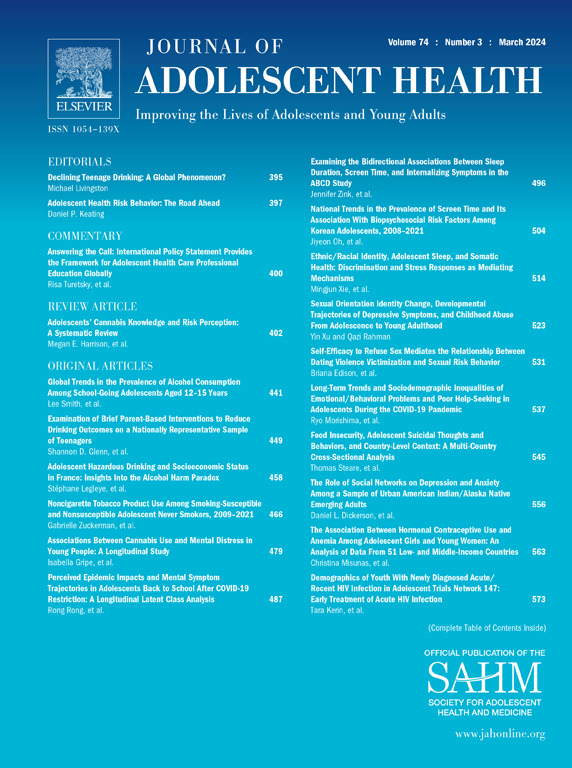美国青少年中亲密伴侣暴力与自杀死亡率并存的现象》(Co-occurrence of Intimate Partner Violence and Suicide Mortality Among Adolescents and Young Adults in the United States)。
IF 5.5
2区 医学
Q1 PEDIATRICS
引用次数: 0
摘要
目的:自杀是美国 10-24 岁人群的第二大死因。亲密伴侣暴力(IPV)也很普遍,研究表明 IPV 与青少年自杀风险有关。然而,对这种关联性的调查研究却十分有限。我们对IPV之前或同时发生(即IPV相关)的青少年自杀事件进行了深入分析,以了解死者是如何卷入IPV的、所经历的IPV类型以及之前法律系统的介入情况:利用美国国家暴力死亡报告系统(2014-2018 年)中 7-24 岁自杀死者的数据(n = 15430 例死亡),我们人工审核了与 IPV 相关的自杀案例(n = 882 例)的案例叙述,并对 IPV 情况的细节进行了编码。我们进行了双变量分析,将 IPV 相关自杀与其他(非 IPV)青少年自杀进行了比较,并使用多变量逻辑回归法研究了 IPV 施暴者(n = 651)和受害者(n = 81)之间前因情况的差异:在与 IPV 相关的自杀事件中,大多数死者为男性,并被描述为 IPV 施暴者。最常报告的是身体上的 IPV。与有过 IPV 施暴史的死者相比,有 IPV 受害史的死者多为女性且更年轻。在 IPV 受害人的叙述中,报告身体 IPV 的几率更高;在 IPV 施害者的叙述中,报告心理 IPV 的几率更高:未来的研究应探索 IPV 施暴与自杀之间的关系以及对幸存伴侣的潜在影响。研究和实践应寻求为青少年制定有效的评估和干预措施,以同时解决 IPV 和自杀风险问题。本文章由计算机程序翻译,如有差异,请以英文原文为准。
Co-occurrence of Intimate Partner Violence and Suicide Mortality Among Adolescents and Young Adults in the United States
Purpose
Suicide is the second leading cause of death among people ages 10–24 in the United States (US). Intimate partner violence (IPV) is also prevalent, and studies suggest that IPV is associated with youth suicide risk. However, limited research has investigated such associations. We conducted an in-depth analysis of youth suicides that were preceded by or coincided with IPV (i.e., IPV-related) to characterize how decedents were involved in IPV, IPV types experienced, and prior legal systems involvement.
Methods
Using US National Violent Death Reporting System (2014–2018) data for suicide decedents aged 7–24 (n = 15,430 deaths), we manually reviewed case narratives for IPV-related suicides (n = 882) and coded details concerning IPV circumstances. We conducted bivariate analyses to compare IPV-related suicides to other (non-IPV) youth suicides and examined differences in antecedent circumstances between IPV perpetrators (n = 651) and victims (n = 81) using multivariable logistic regression.
Results
Among IPV-related suicides, most decedents were male and were described as IPV perpetrators. Physical IPV was most frequently reported. Compared to decedents with a history of IPV perpetration, decedents with a history of IPV victimization were more often female and younger. Narratives of IPV victim decedents had higher odds of reporting physical IPV; narratives of IPV perpetrator decedents had higher odds of reporting psychological IPV.
Discussion
Future research should explore the relationship between IPV perpetration and suicide and potential impacts on surviving partners. Research and practice should seek to develop effective assessments and interventions for young people that address IPV and suicide risk simultaneously.
求助全文
通过发布文献求助,成功后即可免费获取论文全文。
去求助
来源期刊

Journal of Adolescent Health
医学-公共卫生、环境卫生与职业卫生
CiteScore
10.40
自引率
3.90%
发文量
526
审稿时长
46 days
期刊介绍:
The Journal of Adolescent Health is a scientific publication dedicated to enhancing the health and well-being of adolescents and young adults. Our Journal covers a broad range of research topics, spanning from the basic biological and behavioral sciences to public health and policy. We welcome a variety of contributions, including original research papers, concise reports, literature reviews, clinical case reports, opinion pieces, and letters to the editor. We encourage professionals from diverse disciplines such as Anthropology, Education, Ethics, Global Health, Health Services Research, Law, Medicine, Mental and Behavioral Health, Nursing, Nutrition, Psychology, Public Health and Policy, Social Work, Sociology, and Youth Development to share their expertise and contribute to our mission of promoting adolescent health. Moreover, we value the voices of young individuals, family and community members, and healthcare professionals, and encourage them to submit poetry, personal narratives, images, and other creative works that provide unique insights into the experiences of adolescents and young adults. By combining scientific peer-reviewed research with creative expressions, our Journal aims to create a comprehensive understanding of the challenges and opportunities in adolescent and young adult health.
 求助内容:
求助内容: 应助结果提醒方式:
应助结果提醒方式:


